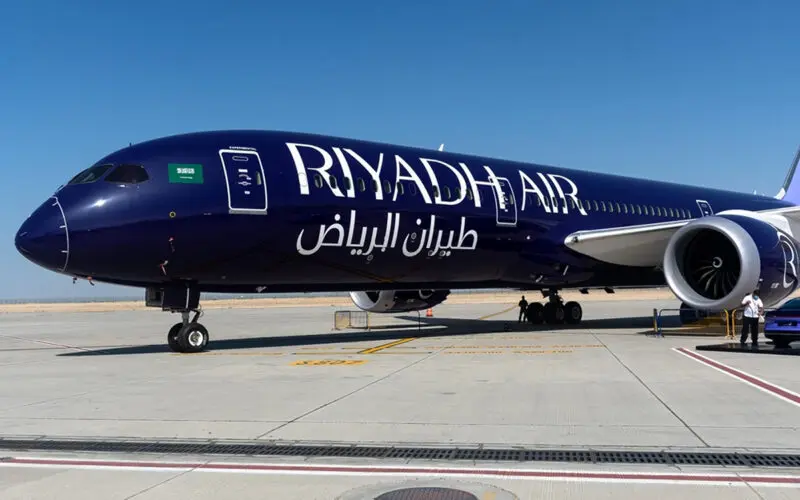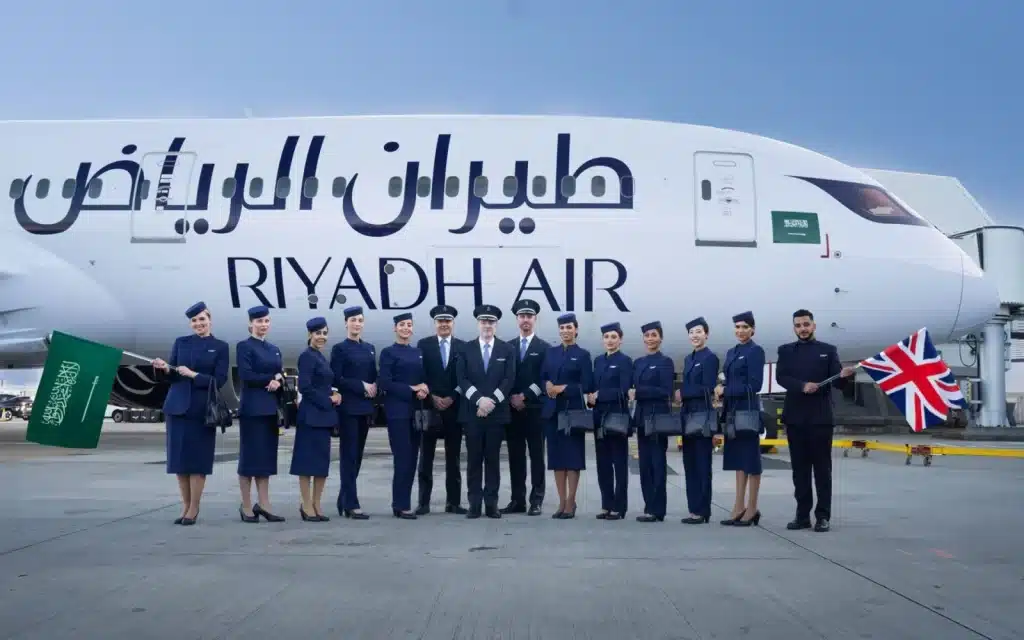Aviation News
Riyadh Air signs 787-9 lease deal ahead of own fleet arrival
Fleet move shows Riyadh Air signing a lease with Saudi-owned AviLease for a single Boeing 787-9 Dreamliner, set for delivery in Q4 2025, positioning AviLease as the carrier’s inaugural lessor; you should note this reliance on leased capacity before its own fleet arrives is operationally significant. The airline’s maiden passenger flight to London and its orders for A321neo, A350-1000 and 39 787-9s underline a rapid expansion strategy that will shape your view of Saudi aviation ambitions.
Riyadh Air Overview
Built around a rapid fleet build-up, Riyadh Air pairs hefty orders with targeted leases to accelerate operations. You can see this in the 60 A321neo, 25 A350-1000 and 39 787-9 orderbook and the recent leased 787-9s — including the AviLease agreement with Q4 2025 delivery — which collectively underpin its near-term network rollout and launch strategy.
Background and Vision
Founded with strong PIF backing, Riyadh Air aims to position Riyadh as a global aviation hub by offering a premium, fuel-efficient product. You should note the carrier’s explicit focus on younger widebodies and narrowbodies to deliver a high-frequency, long-haul network that supports international connectivity and a differentiated guest experience.
Role in Saudi Aviation Ecosystem
Serving as an accelerator for the Kingdom’s aviation ambitions, Riyadh Air is designed to diversify capacity beyond Saudia and attract transfer traffic through RUH. You’ll see this in strategic leasing partnerships — AviLease as inaugural lessor — and in commitments that stimulate training, ground services and leasing-market development.
By design, deliveries and leases accelerate market entry: you’ll note the maiden RUH–LHR passenger flight on Oct 26, 2025 using an Oman Air‑leased 787-9, while the AviLease 787-9 due Q4 2025 and impending official deliveries compress the runway-to-service timeline, increasing pressure on incumbents and driving immediate demand for slots, ground capacity, training and local supply-chain activity.
Lease Agreement Details
The lease secures a single Boeing 787-9 with delivery scheduled for Q4 2025, giving you immediate long‑haul capacity while your own fleet ramps up; the deal also positions AviLease as the airline’s inaugural lessor and bridges the gap between your maiden operations and the arrival of the 39 Dreamliners on order.

Partnership with AviLease
You gain a partner rooted in the Saudi aviation ecosystem: AviLease is Saudi‑owned and pitched as an investment‑grade leasing platform, offering asset support, local market alignment and the credibility that comes with being Riyadh Air’s first external lessor, reinforcing both operational readiness and investor confidence.
Specifications of the Boeing 787-9
The 787‑9 typically seats around 290 passengers in a two‑class layout, offers a manufacturer range of about 7,530 nm (13,950 km), and delivers roughly a 20% fuel‑burn improvement over previous‑generation widebodies, with engine choices including GE GEnx or Rolls‑Royce Trent 1000.
Its composite airframe and advanced systems lower operating costs and noise; you’ll also see tangible passenger benefits — the 787‑9 maintains a cabin altitude near 6,000 ft and higher humidity for comfort on ultra‑long sectors, while robust ETOPS performance keeps your route options flexible.
Operational Milestones
You’ve seen the programme move from plan to action with two headline milestones: the Oct 27, 2025 lease agreement for a Boeing 787-9 from AviLease (delivery slated Q4 2025) and the Oct 26, 2025 maiden passenger flight RUH–LHR. Both steps confirm AviLease as the inaugural lessor and give you tangible evidence that fleet build‑out and commercial operations are progressing on a defined timeline.
Maiden Passenger Flight
That maiden passenger flight on Oct 26, 2025 from Riyadh King Khalid (RUH) to London Heathrow (LHR) used a 787-9 leased from Oman Air and carried Riyadh Air and PIF staff, signalling operational readiness for long‑haul services and validating crew training, cabin procedures and ramp operations under real commercial conditions.
Inaugural Routes and Destinations
You can read the RUH–LHR sortie as a deliberate opening play into major European markets, supported by Riyadh Air’s orders for 60 A321neo, 25 A350‑1000 and 39 787‑9, with the first official delivery expected before year‑end, giving you a mixed narrow‑ and widebody capability from the outset.
Expect initial network choices to prioritise high‑yield trunk routes and strong connectivity: LHR demonstrates demand to London business and transfer traffic, while the 787‑9’s ~7,530 nm range and the A350‑1000’s longer reach allow non‑stop services to Europe, South Asia and parts of North America. Operationally you’ll see Riyadh Air focus on securing slots at congested gateways, completing ETOPS and long‑haul certification for the 787 fleet, and phasing A321neos onto dense regional sectors to optimise frequency and yield.
Future Fleet Plans
You should expect Riyadh Air to scale quickly, leaning on a mix of leased 787-9 bridges and its ordered fleet of 60 A321neo, 25 A350-1000 and 39 787-9; delivery activity ramps toward year-end 2025 as the carrier phases in both short- and long-haul capability to support your network ambitions.
Orders and Expected Deliveries
You’ll note the airline’s firm book shows 60 A321neo for dense short-/mid-haul, 25 A350-1000 for ultra-long, and 39 787-9 for long-range widebody operations; the leased 787-9 from AviLease is slated for Q4 2025 while the first official manufacturer deliveries are expected before year-end.
Aircraft Types and Expected Role
For your route planning, the A321neo will serve regional trunk and thin long sectors, the 787-9 will balance range and efficiency on long thin routes, and the A350-1000 will target high-capacity intercontinental flows, giving you a flexible, fuel-efficient mix aligned with Riyadh Air’s network goals.
Operationally, you should expect these specifics:
- A321neo — narrowbody, high CASM efficiency on 2–6 hour sectors.
- A350-1000 — flagship widebody for 12+ hour high-capacity routes.
- 787-9 — long-range, lower trip costs on medium-density intercontinental sectors.
- After AviLease delivered the leased 787-9 in Q4 2025, fleet commonality and scheduling cadence will shape your initial capacity rollout.
| Aircraft | Role / Timing |
| A321neo | Short‑/mid‑haul trunk routes; 60 on order for network densification |
| A350-1000 | High-capacity, ultra‑long haul; 25 on order for flagship intercontinental services |
| 787-9 | Flexible long‑range widebody; 39 on order plus leased units for near-term ops |
| Leased 787-9 (AviLease) | Delivered Q4 2025 to bridge fleet until manufacturer deliveries arrive |
Industry Implications
You should see the AviLease 787-9 lease as a market signal: by securing a single Boeing 787-9 Dreamliner for delivery in the final quarter of 2025, Riyadh Air accelerates launch timelines, pressures global lessors to compete for Gulf business, and strengthens PIF-backed momentum. This move, paired with Riyadh Air’s orders for 60 A321neo, 25 A350‑1000 and 39 787‑9, reshapes capacity planning for long-haul and narrowbody networks and nudges leasing rates and availability in your favour or against competing carriers.
Impact on Global Aviation Market
You can expect immediate competitive effects: the maiden passenger flight on October 26, 2025 (RUH–LHR) demonstrated operational intent and route ambition, while the 787‑9’s long range and fuel efficiency will let Riyadh Air contest premium intercontinental markets. Established Middle Eastern hubs may face route cannibalisation, leasing demand will rise as new entrants seek interim capacity, and you’ll see pressure on yields on select Europe–Gulf and Gulf–Asia sectors.
Positioning within Saudi Arabia’s Vision 2030
You should view Riyadh Air as a tactical instrument of Vision 2030: backed by the Public Investment Fund (PIF) and fast-tracked via leased 787s, the carrier boosts tourism capacity, connects giga-projects and supports the Kingdom’s broader economic diversification goals. Its fleet plan directly feeds national targets for international connectivity and job creation, aligning aviation growth with planned increases in inbound leisure and business travel.
More specifically, you’ll notice practical outcomes: the AviLease partnership builds domestic leasing capability and supply-chain depth, leased 787s let you launch long-haul routes before factory deliveries arrive, and early operations (including the Oman Air‑leased 787‑9 used for the maiden flight) create immediate demand for crew training, MRO expansion and airport slot coordination—concrete steps that advance Vision 2030’s transport and tourism metrics.
Stakeholder Perspectives
Remarks from Riyadh Air Leadership
You see Riyadh Air’s CFO framing the AviLease agreement as a step toward a young, fuel-efficient fleet; the signed lease for a single Boeing 787-9 with delivery in the final quarter of 2025 complements existing orders—60 A321neo, 25 A350-1000 and 39 787-9—and supports operations after the Oct 26, 2025 maiden RUH–LHR passenger flight aboard a leased 787-9.
Insights from AviLease CEO
You can gauge AviLease’s strategy from Edward O’Byrne’s emphasis on building an investment-grade leasing platform; becoming Riyadh Air’s first leasing partner positions AviLease to compete globally while directly supporting the Kingdom’s aviation ecosystem and the timely introduction of the 787-9 into service.
Beyond optics, AviLease’s role gives you a practical bridge: supplying a 787-9 in Q4 2025 that helps train crews, validate long-haul routes and keep launch schedules on track; its Saudi ownership and links to the PIF suggest lease terms designed to absorb early operational risk while Riyadh Air awaits bulk deliveries before year-end.
Conclusion
Now you can see Riyadh Air’s 787-9 lease with AviLease accelerates operational readiness while its own fleet is staged for delivery; the Q4 2025 Dreamliner lease makes AviLease the carrier’s first lessor and supports the airline’s recent maiden passenger flight to London, giving you confidence that Riyadh Air is building a fuel-efficient, modern network ahead of full fleet arrival.
Frequently Asked Questions
What lease agreement has Riyadh Air signed for the Boeing 787-9?
Riyadh Air has signed a lease agreement with AviLease (a Saudi-owned aircraft lessor) for a single Boeing 787-9 Dreamliner, with delivery scheduled in the fourth quarter of 2025.
Why is Riyadh Air leasing a 787-9 ahead of its own fleet arrival?
The lease allows Riyadh Air to accelerate readiness — enabling crew training, operational testing and promotional flights ahead of the full fleet rollout. It helps the startup carrier build momentum and infrastructure while awaiting its own new-aircraft deliveries.
What is the wider fleet plan for Riyadh Air in terms of aircraft types?
Riyadh Air has placed orders for 39 Boeing 787-9s (with additional options) and roughly 60 Airbus A321neo family aircraft, targeting a young and fuel-efficient fleet for global network expansion.
When will the leased Boeing 787-9 be delivered and start operations?
The aircraft is scheduled for delivery in Q4 2025. Specific entry into commercial scheduled service has not been publicly confirmed, though substantial preparations are underway.
How does this lease deal support Riyadh Air’s strategic ambitions?
The lease agreement signals Riyadh Air’s intent to quickly establish itself in the global aviation market, leveraging its hub in Riyadh for an ambitious network of over 100 destinations by 2030. It complements Saudi Arabia’s wider aviation growth and diversification strategy.
What aircraft configuration and cabin product has Riyadh Air announced for its 787-9?
Riyadh Air has revealed preliminary cabin plans for the 787-9: up to 28 business-class seats (including four “Business Elite”), 39 premium economy seats and 223 economy seats. The airline intends a consistent cabin product across its fleet.

